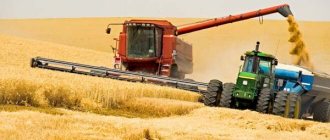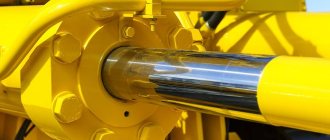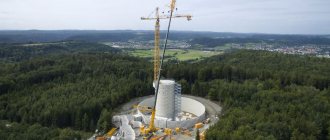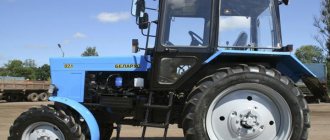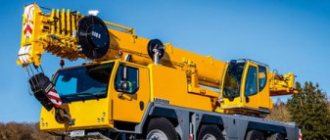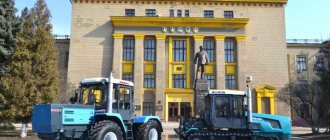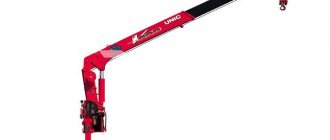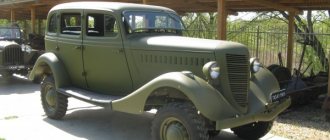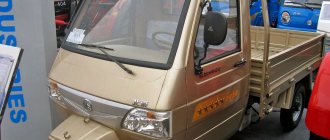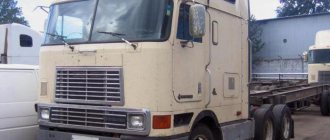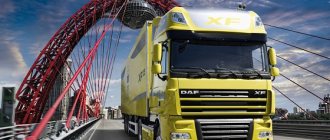In the control of the MTZ 80(82) tractor with hydrostatic steering (HSC), the wheels are turned due to the operation of a double-acting hydraulic cylinder. The unit is installed on the front axle beam and is connected by a working rod to the rotary lever of the steering linkage of the steered wheels. The material will discuss the hydraulic cylinders used as part of the hydrostatic steering on MTZ 82(80) tractors, their characteristics and varieties.
As part of the MTZ 80(82) steering system with power steering , direct rotation of the steering bipod is carried out by the operation of a hydraulic cylinder as part of the steering column itself, where oil pressure is supplied to the working cavities through a distributor built into the unit. The change in the position of the spool in the power steering distributor occurs from the worm gear axis, which receives rotation from the tractor steering wheel.
Hydraulic cylinder of the MTZ-80/82 blade (T-40, YuMZ-6)
| Day | Working hours | Break |
| Monday | 09:00 — 18:00 | |
| Tuesday | 09:00 — 18:00 | |
| Wednesday | 09:00 — 18:00 | |
| Thursday | 09:00 — 18:00 | |
| Friday | 09:00 — 18:00 | |
| Saturday | Day off | |
| Sunday | Day off |
* Time specified for the region: Russia, Ufa
Description
Currently, the market for attachments for MTZ-82 type tractors is quite wide. One of the most popular units are utility and bulldozer blades. Naturally, in this case you cannot do without hydraulics. The simplest blades are equipped with a hydraulic cylinder for raising the blade, while more complex ones have a hydraulic cylinder for rotating the blade. Each manufacturer uses a blade hydraulic cylinder that is more suitable for a particular blade design or based on the technical and economic requirements of the attachment.
As practice shows, hydraulic cylinders with a piston diameter of 50 to 80 mm are used as a hydraulic cylinder for a blade for Belarus-type tractors.
The most “budget” versions of “shovels” are equipped with hydraulic cylinders C50-3405215 (steering hydraulic cylinder MTZ-80/82), 50.30x400.11 (22), 50.30x500.11 (22), C75/30x200 -3.44 (515) (Ts75x200 -3) or its analogue MS75.30x200.44. The safety margin of such cylinders is small due to their design features, although much depends on the kinematic diagram of the blade itself.
Serious manufacturers of attachments use hydraulic cylinders from the following line as blade hydraulic cylinders: 80.40x200.22, 80.40x250.22, 80.40x320.22 (80.40x320.11), 80.40x400.22. Often bulldozer blades are equipped with a hydraulic cylinder 80.56x280.11 (80.50x280.11), like the EO-2621 type excavator blades.
Sometimes you can see something in between these options: moldboard hydraulic cylinders with a piston diameter of 63 mm: 63.30x200.11, 63.30x250.11, 63.30x320.11, 63.30x400.11.
You can pick up all options for hydraulic cylinders for the MTZ-80/82 blade from our warehouse in Ufa.
KO - 80.40x200.22 (KO-18.000), 80.40x320.22
Source
Description and characteristics
The MTZ 82 linkage cylinder is the most important component of the design of the working mechanism; it is used to hold it in a certain position, raise, lower, and perform various tasks. A similar element is used for the correct operation of attachments, as well as trailed devices. This kind of element has the identification number ts-100x200-3, which makes it easy to find it in the spare parts catalog. Among the characteristics of such a product it is worth noting:
- weight - 22 kg;
- nominal/maximum pressure - 16/20 MPa;
- working cylinder diameter - 10 cm;
- piston stroke - 20 cm;
- rod - 4 cm;
- nominal/maximum operating speed - 0.15-1 m/s.
A hydraulic cylinder is a part of hydraulic equipment
. It should be mentioned that a cylindrical element of this type has a wide range of applications; it is used in popular models of tractors MTZ 50, 80, 82, as well as YuMZ-6, which makes the components interchangeable. The hydraulic cylinder model is of the piston type and has a two-way operating principle. Moreover, it is made according to an outdated model, which is currently practically not used in new technology. It is called the main one because it is used to perform most tasks.
In addition to the above-mentioned cylinder, the design of the product contains 2 more similar elements with a diameter of 7.5 cm. This kind of product is called remote, since they are mounted on the body of the unit, and communication with the main hydraulic system is carried out through special pipelines and hoses.
Device
It should be noted that all cylinders installed in the tractor design are completely identical to each other in their operating principle and technical design, and their main difference is the size of the parts. When studying the structure of the main hydraulic cylinder, it is advisable to highlight several key elements of its design. Among them:
- frame;
- back and front covers;
- rod cavity and fork;
- oil line;
- piston and rod;
- MTZ 82 hydraulic cylinder mounting bracket, studs and valves.
Be sure to read: How to make your own herb grinder
The internal structure of the product deserves a more detailed consideration. The body appears to be a special pipe, the inside of which has been processed. It is sealed by means of rings, which are located in the corresponding cavities of the back and front covers. The studs provided by the design are used to securely connect such elements to the body, and a fork is located at the end of the back cover. It is important to remember that the cylinders with a diameter of 7.5 cm use cast iron as the material for the cover, while the main hydraulic cylinder uses high-strength steel. The oil required for the operation of the mechanism enters through the corresponding hole located in the front cover. The cylinder of the MTZ tractor is constructed in such a way that when the rod is retracted, the attachment is lifted. The stop in the extreme position does not interfere with the movement of the rod, but helps move the valve to a special place on the product cover.
If desired, the owner of tractor equipment from MTZ can adjust the stroke of the rod. This will allow you to use the unit when working with equipment that requires restrictions when lifting the attachment. Similar manipulations may be required when using devices that work with a connection to the rear power take-off shaft.
Hydraulic cylinder at MTZ
Hydraulic cylinder of the rear linkage of the Belarus MTZ 82 tractor
The hydraulic power cylinder of the rear linkage is an important component of the tractor's hydraulic linkage system. The function of the unit is to regulate the height of the mounted device and the aggregated implements attached to it. The cylinder is also a unit through which the drive wheels are reloaded with a hydraulic loader and all types of regulation of the working position of mounted land-cultivating devices with the participation of power (positional), height and mixed regulation systems built into the tractor hydraulics.
User manual
The operation of the units does not cause any difficulties, which is due to the ease of use of the tractor’s hydraulic mechanism. In some cases, the unit may need to be adjusted correctly to make it effective and safe to use.
Adjustment is carried out by changing the length of the braces, as well as the thrust. With the help of the former, it is possible to adjust the transverse arrangement of the equipment, and with the help of the central rod, the longitudinal arrangement. Since the weight of most types of attachments used with tractors in this series is impressive, the mechanism periodically sags. This situation can be corrected using a special fixation mechanism, which is mounted directly on the cylinder bracket and allows you to securely secure its position.
Be sure to read: Homemade tedder rake for walk-behind tractor
Unit specifications
The unit is a double-acting piston-type hydraulic power unit, where the direction of movement of the working stroke of the rod is controlled by the hydraulic cylinder section when supplying working fluid under pressure into the rodless or rod cavity, providing lifting or lowering of the hitch. In general, the force of the hydraulic cylinder and the operation of the articulated parts of the rear linkage of the MZ 82 provide a load capacity on the suspension axis of up to 3200 kg.
As a standard, the main hydraulic cylinder TS 100/40/200 with the following technical parameters is installed in the MTZ 82(80) hydraulic mounted systems:
- Cylinder diameter - 100 mm
- Rod diameter - 40 mm
- Working stroke of the rod - 200 mm
- Weight - 19 kg
- Piston speed - 0.2 m/s
- Nominal pressure -16 mPa
- Maximum pressure - 20 mPa
This unit is produced by a number of manufacturers and can be abbreviated as: TsG 100.40-200.01, STs 200-100, Ts 100x200.
Characteristics of steering hydraulic cylinders for MTZ 82(80)
Depending on the current loads on the front axle and the nature of the use of the tractor, the hydraulic cylinders of the following brands are installed in the hydraulic cylinders of the MTZ 82: ГЦ50Х25Х200, ГЦ63Х30Х200
| Options | ГЦ50Х25Х200 | ГЦ63Х30Х200 |
| Catalog markings of the unit | Ts50-3405215A Ts50.25.210.415 ГЦ50х25х200.11 | Ts63-340512A Ts63x25x200.11 ГЦ63х25х200.11 |
| Working cylinder diameter, mm | 50 mm | 63 mm |
| Rod diameter, mm | 25 mm | 30 mm |
| Rod stroke, mm | 200 mm | 200 mm |
| Axle distance Folded, mm Unfolded, mm | 405 605 | 465 665 |
| Eye diameter, mm | 25 | 30 |
| Nominal pressure, mPa | 17 | |
| Maximum pressure, mPa | 20 | |
| Nominal rod speed, m/s | 0,12 | |
| Maximum rod speed, m/s | 0,3 | |
| Nominal pushing force, kN | 22,4 | 47,7 |
| Nominal pulling force, kN | 12,9 | 36,6 |
| Hydromechanical efficiency at rated pressure | 0,92 | |
| Part material | E355(C40) carbon steel | |
| Operating temperature, °C | from -40 to +70 | |
| Specific volume of working fluid carried out through the cuffs | 0,02 | |
| Resource of work, full strokes | 10000 | 10000 |
| Recommended fluids | M-10V2, M-10G2, MGE-46V TU 38.00.1347-2000, HVLP 32 and HVLP 46 according to Din 51524-3-2006 | |
Selecting a hydraulic cylinder when completing a power steering system
As a standard, when equipping the steering control of a tractor with a conventional portal FDA (with bevel pairs of gears in wheel reducers) and a non-drive axle MTZ 80, a hydraulic cylinder of the Ts50X25X200 brand is installed. At the same time, the power steering hydraulic system is equipped with an NSh 10 gear pump and a gerotor metering pump with a capacity of 100 cm³/per revolution. This composition provides sufficient cornering reinforcement and an optimal ratio of steering wheel rotation to steering wheel rotation when performing row-crop work.
If a higher-capacity pump and dispenser are installed in the HPS, the amplification efficiency will increase. At the same time, it will become more difficult to regulate the wheel travel when performing row-crop work, since when the steering wheel is turned, the speed of change in the position of the wheels will increase.
For MTZ tractors of traction class 1.4 of all brands and modifications with a reinforced beam FDA (with planetary helical wheel gearboxes), the steering is equipped with a more powerful hydraulic cylinder of the Ts63X30X200 brand. To ensure the operation of this hydraulic cylinder, the hydraulic cylinder is equipped with an NSh 14 pump and a dispenser with a capacity of 160 cm³/per revolution. And also to increase the efficiency of power steering, it is recommended to install such a set of units on tractors with an increased load on the front axle, for example, when using the tractor for loading operations with a front-end loader or other equipment on the front linkage.
Reference! The hydraulic cylinder ГЦ50Х25Х200 is also used in the steering control of DON 1200,1500 combines. GC63X30X200 cylinders are installed as part of the MOUNTAIN on combine harvesters DON, NIVA SK 5, YENISEY, SK-6 KOLOS. In addition, it should be clarified that these components are used in the steering control of the entire MTZ model range. Thus, on tractors of the 2nd and 3rd traction classes - MTZ 1221 , 1523 , 2022 , a pair of steering cylinders ГЦ50Х25Х200 is installed, on tractors of 4-5 classes MTZ 3022 , 3522 a pair of hydraulic cylinders ГЦ63Х30Х200 are installed.
Two hydraulic cylinders ГЦ50Х25Х200 as part of the MTZ 1523 hydrostatic steering control
Device
The hitch cylinder of the MTZ 82(80) tractor is located under the tractor cabin in the gap between two fuel tanks. The hidden location of the unit, on the one hand, fits organically into the design of the tractor and does not interfere with setting up the hitch; on the other hand, its difficult accessibility complicates repairs in cases of failure.
The design of the unit is a metal cylinder body with a working piston and rod installed inside. The ends of the body are closed with lids. The body and covers are tightened into a single structure with four studs. The connections of the covers to the body and the covers to the working rod are sealed with cuffs.
Compression to the working piston in the cylinder is provided by rubber rings - on the working outer diameter of the piston, in contact with the working mirror of the cylinder, and in connection with the rod - in the inner landing diameter. The piston is secured to the rod with a nut.
The outer exit of the rod is equipped with scrapers, which are a package of thin metal plates installed in the cover. Scrapers prevent dust and other mechanical contaminants from getting into the sealing collar of the rod, which ensures the overall safety of the working life of the unit. In addition, the rod cap is equipped with a valve for adjusting the stroke of the rod and a retarding valve.
Oil enters the cylinder through fittings in the rod cap. One fitting is connected to the rod cavity, the other is connected to the rodless cavity through a longitudinal tube. The tube is placed in the sockets of the covers on rubber rings and is sealed by tightening the parts with pins.
Steering hydraulic cylinder with double-sided rod
Recently, in the spare parts market, with the popular conversion of the MTZ steering control from power steering to a dispenser , hydraulic steering cylinders with a double-sided rod are offered. The advantage of such a cylinder is that the unit is installed instead of a transverse rod in the steering linkage. Thus, the design of the steering control on the front axle beam is simplified, which is important, for example, for organizing the drive of the power take-off shaft at the front of the tractor. In addition, sellers claim some cost savings during conversion due to the fact that there is no need to purchase a transverse rod in a set of parts.
double-sided hydraulic cylinder
The unit has a rod exit on both sides of the cylinder. The cylinder body is attached to the FDA beam using a bracket. The outer ends of the movable rod are equipped with ball joints, which are connected through threaded ends to the hinges of the swing arms. Depending on the direction of rotation of the steering wheel, pressure is supplied to the corresponding sub-piston cavity of the cylinder, ensuring the exit of one side of the rod and the entry of the other. Thus, the movement of the piston with the rod relative to the stationary cylinder fixed to the axle beam ensures rotation of the trapezoid arms and rotation of the wheels.
Features of the characteristics of double-sided steering cylinders
When choosing a unit, based on the design of the front axle, the nature of the use of the tractor, among the proposed cylinders with a double-sided rod and other parts for conversion, you need to pay attention to:
- The working stroke of the rod must be at least 200 mm. If a unit with a stroke of less than 200 mm is installed, the steering will not provide maximum wheel rotation for the minimum turning radius of the tractor. There are units on the market with a stroke of 200, 250, 300 mm. The stroke length of the rod is selected depending on the make of the tractor, taking into account the length of the swing arms or the design distance from the axis of rotation of the wheel to the point of connection of the swing arm with the cylinder. For example, for a normal turning radius on the YuMZ-6 tractor, a cylinder with a stroke of 300 mm is needed, since the longitudinal swing arms of the trapezoid are slightly longer than those of the MTZ 80, and a larger working stroke is needed to fully turn the wheels.
- Cylinders with standard characteristics have a rod diameter of 25, 30 mm, and a cylinder diameter of 50 mm. Reinforced units with a rod diameter of 40.45 mm and a cylinder diameter of 55.63.
- The amplitude of the rotation angles of the ball joints should ensure organic operation of the rotating mechanism joints with minimal lateral loads on the cylinder rod, which will preserve the working life of the unit.
- The length of the tubular threaded part of the limit switches connecting to the rod joints must ensure the width of the installed track and its adjustment if necessary, as well as the necessary installation of the toe of the steered wheels along the front edge of the rim.
- The set of mounting brackets for the steering cylinder must match the design of the tractor's front axle.
Typical breakdowns
Signs of poor mechanical condition of the unit include low lifting capacity of the cylinder, constant oil leakage and poor ability to hold the attachment in the raised position.
According to the technical requirements of the manufacturer, the cylinder is considered to be in good condition if the raised linkage with attached equipment weighing 500 kg, in the position of the retracted rod ¾ of the working length, within 30 minutes, allows the equipment to lower by no more than 25 mm of the rod exit.
The main reasons for node failure are:
- working rod deflection
- wear of sealing elements
The relative misalignment of the assembly parts caused by the bending of the rod provokes rapid, uneven wear of the rubber rings of the piston and the seals of the rod exit point, which is manifested by short-term proper operation of the cylinder.
Wear of the piston O-rings reduces cylinder performance due to increased oil leakage from the injection cavity to the oil discharge cavity. Violations in the seals of the joints of the covers with the body and the rod with the cover cause external oil leakage, which also reduces productivity and causes additional wear of the assembly parts as a result of abrasive dust getting inside the hydraulic cylinder.
The main effect of solid inclusions in the oil occurs on the cylinder bore and the surface of the working rod, which ultimately leads to unacceptable wear that prevents further operation of the unit. In addition, you need to understand that getting abrasive into the tractor’s hydraulic oil will also negatively affect the life of all components of the system, including the distributor, hydraulic pump and hitch regulators.
To preserve the working life of the hydraulic cylinder and increase safety during transport crossings with attached equipment, it is recommended to use a mechanical locking device for the rear linkage, the use of which eliminates the load on the cylinder.
Our production
- Manufacturing of hydraulic cylinders of any complexity for special, municipal and agricultural equipment, both domestic and imported. In production we use components made in Italy, which ensures long and uninterrupted operation of the hydraulic unit.
- Sale of new hydraulic cylinders and various hydraulic units.
We are registered on all government platforms as well as on the supplier portal, where you can enter into an agreement with us for the repair and maintenance of special equipment.
We produce our own hydraulic cylinders, and we are also the official representative of leading manufacturing plants in Russia, Austria, Italy
The products of our company are distinguished by their high quality, reliability and significant service life. All products are guaranteed and provided with warranty service. We will be glad to see you among our clients. Write to us or call us and we will try to solve your problems as soon as possible.
Features of repair of hydraulic cylinder MTZ 82
To repair the hydraulic cylinder, dismantling the unit can be done in two ways: when removing the right wheel and right fuel tank, or through the cabin when removing the driver's seat through the hatch underneath.
After disassembling, it is important to carry out defect detection of the assembly parts. Particular attention should be paid to the wear and condition of the working surface of the cylinder and the degree of wear of the rod. It is not allowed to operate a cylinder on the working surface of which there are holes, burrs or areas of uneven wear. If more than 0.1-0.2 mm wear on the cylindrical surface of the rod is detected, the part is replaced with a new one. Also, the rod is replaced or adjusted if a part deflection of more than 0.1 mm is detected. The threads in the mounting holes of the assembly parts and the elements connecting the cylinder to the hydraulic system line are not allowed. It is recommended to replace all sealing elements of the unit with new ones when carrying out repairs.
Our main activities
- — Installation of a hydrofiltration system
- — Wholesale and retail sale of hydraulic cylinders
- — Sales and repair of hydraulic hammers
- Repair of hydraulic cylinders of any complexity and any type. Quickly and efficiently, the repair period takes from 1-5 days, depending on the complexity and volume of work performed.
- Repair and maintenance of special, municipal, agricultural and road construction equipment, both domestic and imported. Our mobile team will assist with hydraulic repairs .
- Repair of hydraulic hammers.
- Repair of hydraulic pumps.
- Repair of hydraulic motors.
- Repair of hydraulic valves
- All units have a three month warranty on repairs.
- Repair of power steering for special equipment and imported trucks.
Purpose of the tractor blade
The structure, made of steel sheet with additional reinforcements, is intended for cleaning the road surface or for collecting soil (for example, during excavation work). A cutting element made of special steel is installed along the lower edge of the bulldozer element; on units for public works, a rubber lining is used to protect the road surface from damage (for example, when removing ice or snow). On MTZ wheeled tractors, the blade is mounted at the front; road machines are equipped with an additional scraper.
Types and design of the device
Categories and design features of dumps for MTZ-82:
- A unit for carrying out public works, characterized by reduced weight at the expense of strength. Suitable for removing light materials (e.g. debris or soft soil), can be used on agricultural farms.
- The bulldozer-type device is made of a thickened sheet, to which plates are welded to increase rigidity. The blade is used when carrying out road work or digging trenches.
- A snow shovel is distinguished by the absence of a cutting edge; it is used for cleaning yards and roads; the tool can be used when clearing an area of soft soil.
The characteristics of the dump using the example of a municipal 2-section unit NTU-10 are given in the table.
| Parameter | Meaning |
| Width, m | 2,0-2,6 |
| Productivity, m³ | up to 340 |
| Operating speed, km/h | up to 8 |
| Structure weight, kg | 600 |
| Cost, rub. | from 135 thousand |
How does a blade work?
The blade is mounted on a subframe made of a steel profile, fixedly attached to the tractor frame.
To change the position of the structure and press the working edge to the ground, a 2-way hydraulic cylinder, controlled by a spool valve, is used.
Oil is supplied under pressure by a gear pump driven by an engine.
The tool has a rotating unit that allows you to place the knife at an angle to the longitudinal axis of symmetry of the machine (the position is changed manually or with a separate cylinder).
Features of homemade equipment
The owner of a standard MTZ-82 tractor can independently make a blade from sheets of metal; to ensure functionality, it will be necessary to mount a hydraulic system. It is not recommended to install homemade equipment on equipment that is under warranty.
Due to overload, damage to structural parts may occur; in this case, the plant will refuse free repairs.
Before starting assembly, it is necessary to prepare drawings; it is recommended to assemble the unit in accordance with the dimensions and weight of the factory product.
Advantages and disadvantages
Advantages of a homemade blade for the MTZ tractor:
- low cost (compared to standard equipment);
- Possibility of manufacturing a structure with the required dimensions.
- assembly requires metal-cutting and welding equipment;
- it is necessary to purchase components for mounting the tool on the tractor;
- erroneous determination of dimensions leads to overload of the engine and chassis of the equipment;
- The lack of certificates makes it impossible to officially undergo a technical inspection.
Where is it used?
Homemade products are used by tractor owners in the following cases:
- for cleaning snow and dirt on personal plots;
- when performing earthworks;
- to clear a plot of land for the construction of a residential building or outbuildings;
- for moving crops (for example, grain).
Possible faults
The MTZ hydraulic system is characterized by a long service life, simple and reliable design. However, with use, many of its parts may wear out, which leads to failure of the unit. If desired, repair work can be performed independently by performing troubleshooting, purchasing and replacing damaged elements. An example is hinge joints, which are subject to intense mechanical stress, which negatively affects their service life. In addition, it is often necessary to repair or replace the splined joints of the lift arms, as well as the shaft. Such problems lead to a significant increase in gaps, which complicates the adjustment of attachments and leads to a decrease in processing accuracy. In some cases, it may be necessary to weld and rework damaged areas of the structure.
Maintenance of the hydraulic system of the MTZ hinged mechanism comes down to timely lubrication of the mechanism using standard elements, as well as monitoring the degree of wear of the component elements.
What materials and tools will be needed
If the owner intends to make a blade with his own hands, then it is necessary to prepare:
- carbon steel sheet 8 mm thick for the manufacture of the main part of the scraper;
- steel channel for assembling the frame necessary for mounting the tool;
- double acting hydraulic cylinder;
- pipelines for connecting the cylinder to the pump;
- spool valve;
- swivel connectors;
- electric drill or drilling machine;
- tool for cutting steel profiles and sheets;
- welding machine;
- measuring and drawing tools;
- a thick rubber plate (in case of assembling a snow blower);
- mounting bolts and nuts (in accordance with the documentation).
Assembling a blade for a MTZ tractor
Possible designs of dumps for tractors:
- welded scraper with hydraulic control;
- steel structure with a rotor driven by an internal combustion engine;
- snow blower with electric power drive.
The easiest way
A brief algorithm for assembling a welded blade with hydraulic control:
- Mark the outline of the blade on a steel sheet, and then cut out the workpiece. It should be taken into account that the lateral extension of the scraper relative to the width of the tractor is allowed by no more than 400 mm to the side.
- Treat the edges with an abrasive tool, removing burrs.
- Drill 8-10 holes in the bottom to install the rubber plate. If the blade is not planned to be used as a snowplow, then leave the lower edge monolithic.
- Weld on the rear edge of the sheet the sections of channel necessary for installing the equipment on the subframe.
- Mark the steel profile and weld the subframe, which is attached to the front of the tractor through standard holes.
- Install the hinge joints, weld the joints and pre-install the structure on the tractor.
- Mark and weld brackets to which to attach the hydraulic cylinder for raising and lowering the blade.
- Route the hoses to the spool valve and connect the power drive to the tractor hydraulics.
- Tighten the threaded connections and check the operation of the unit; if distortions or jamming are detected, modify the design.
Summing up
To manufacture a blade for a tractor, welding and metal-cutting equipment is required; the tractor owner must have the skills of a designer and welder. A homemade design expands the capabilities of the equipment, but if there are errors in the calculations, the blade can damage the machine. It should be taken into account that when assembling scrapers of complex geometric configuration, the costs of materials and components increase. How can you save additional money and what designs of homemade dumps are used by owners for cleaning or clearing the territory?
Source
